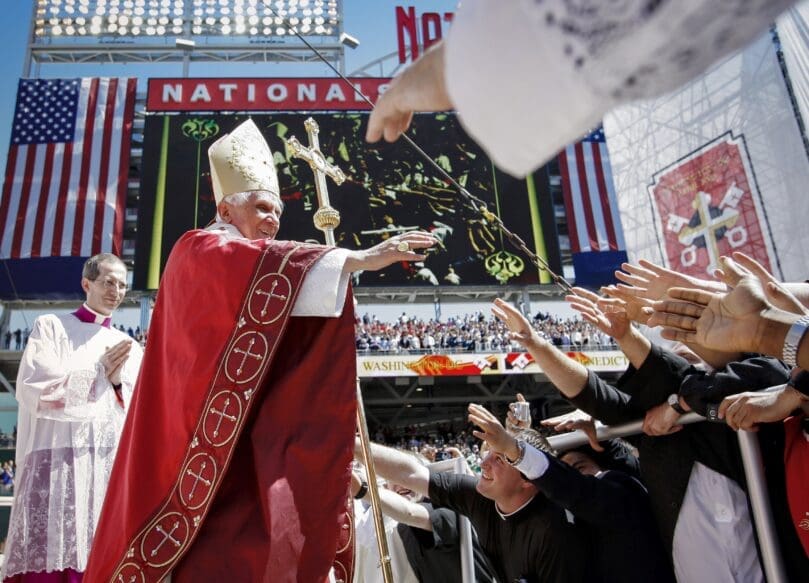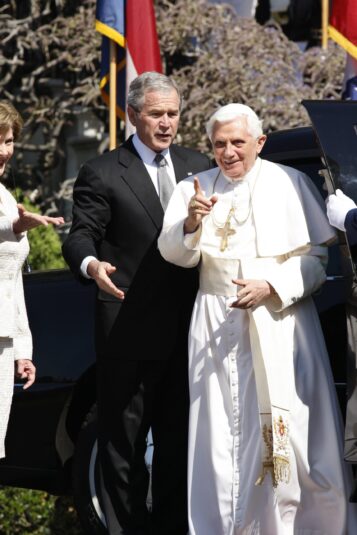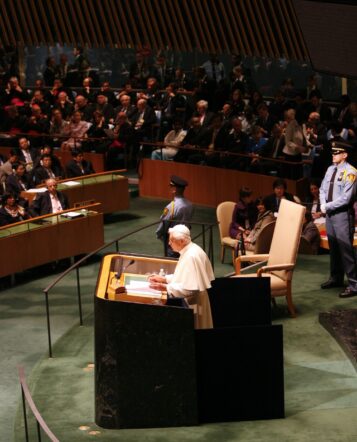 CNS photo/Nancy Wiechec
CNS photo/Nancy WiechecWashington, DC
Pope Benedict’s 2008 U.S. visit a whirlwind with timely, pointed messages
By MARK PATTISON, OSV News | Published December 31, 2022
WASHINGTON (CNS)–When Pope Benedict came to the United States for a visit to Washington and New York spanning six days in mid-April 2008, some news accounts called the pace of his schedule “grueling.”
Pope Benedict handled the pace with good grace while getting his message out to millions of Catholics both in the United States and throughout the world. He died at the Vatican Dec. 31.
The trip had been timed to help celebrate the bicentennials of four archdioceses in the United States: New York, Boston, Philadelphia, and Louisville, Kentucky. They were erected from the Baltimore Diocese, the nation’s first diocese, which was elevated to an archdiocese in the same year, 1808.
But it was the abuse crisis, which burst onto front pages in 2002 and persists to this day, that was a central focus of Pope Benedict’s trip; this was the first papal visit since the scandal started making headlines in the U.S.
At a Mass at the brand new Nationals Park in Washington, Pope Benedict said that “no words of mine could describe the pain and harm inflicted by such abuse. It is important that those who have suffered be given loving pastoral attention.”
The pope lauded the efforts to deal “honestly and fairly with this tragic situation and to ensure that children–whom Our Lord loves so deeply and who are our greatest treasure–can grow up in a safe environment.”
“I encourage each of you to do what you can to foster healing and reconciliation and to assist those who have been hurt. Also, I ask you to love your priests, and to affirm them in the excellent work that they do,” he said.
Later that day, he met privately with a group of abuse survivors at the apostolic nunciature; the meeting was a first for a pope.
Pope Benedict’s Washington itinerary included an audience with the U.S. bishops and an appearance at The Catholic University of America, the nation’s papally chartered university, to speak to educators. He also presided over a vespers service at the Basilica of the Shrine of the Immaculate Conception.

Pope Benedict XVI is pictured with U.S. President George W. Bush at the White House April 16, 2008. CNS photo/Nancy Wiechec
The pope met with President George W. Bush inside the White House, emerging to cheering throngs outside as the pope and the president exchanged greetings.
In his meeting with the bishops, Pope Benedict acknowledged the “evil” of the clerical sexual abuse crisis and encouraged them to continue their work to restore trust in the church and its ministers.
Talking to educators at The Catholic University of America, he said today’s challenges require sound instruction in the faith, especially among the young. But they also call for “cultivating a mindset, an intellectual culture, which is genuinely Catholic” and can bring the Gospel to bear on the urgent issues American society faces.
Before heading to New York, Pope Benedict met with 200 representatives of Islam, Jainism, Buddhism, Hinduism and Judaism gathered at the Pope John Paul II Cultural Center, and on his way to an ecumenical prayer service in Manhattan, Pope Benedict stopped to greet Jewish leaders at the Park East Synagogue.
At the synagogue, Pope Benedict expressed his respect for the city’s Jewish community and encouraged the building of “bridges of friendship” between religions. The encounter marked the first time a pope had visited a Jewish place of worship in the United States, and it came a day before the start of Passover.
At the ecumenical prayer service, Pope Benedict said the witness of Christians in the world is weakened not only by their divisions, but also by some communities turning their backs on Christian tradition.
“Too often those who are not Christians, as they observe the splintering of Christian communities, are understandably confused about the Gospel message itself,” he said.
He also praised the ecumenical commitment of U.S. Christians and acknowledged that the agreements found in their theological dialogues have contributed to the theological agreements later forged by the Vatican and its official dialogue partners.
Celebrating Mass in New York’s St. Patrick’s Cathedral with thousands of priests and religious, the pope urged the Catholic Church in the United States to move past divisions and scandal toward a “new sense of unity and purpose.” It is time, he said, to “put aside all anger and contention” inside the church and embark on a fresh mission of evangelization in society.
Honoring the bicentennial of four U.S. archdioceses, Pope Benedict praised the “solid foundations” of the American Catholic Church and said that “the future of the church in America” must continue to build on that “impressive legacy.”
But in his homily for the final U.S. Mass, celebrated at Yankee Stadium, he also said the “impressive growth” of the U.S. church has been “not without its challenges,” comparing those challenges to the “linguistic and cultural tensions” found in the early church.
“In these 200 years, the face of the Catholic community in your country has changed greatly,” Pope Benedict said. “We think of the successive waves of immigrants whose traditions have so enriched the church in America.”
He also lauded “the strong faith which built up the network of churches, educational, health care and social institutions which have long been the hallmark of the church in this land,” as well as “those countless fathers and mothers who passed on the faith to their children, the steady ministry of the many priests who devoted their lives to the care of souls, and the incalculable contribution made by so many men and women religious.”
In a speech to the U.N. General Assembly, Pope Benedict said neither government nor religion has a right to change or limit human rights, because those rights flow from the dignity of each person created in God’s image. The pope insisted that human rights cannot be limited or rewritten on the basis of national interests or majority rule.

Pope Benedict XVI speaks at the United Nations in New York April 18, 2008. Pope Benedict died Dec. 31 at the age of 95 in his residence at the Vatican. CNS photo/Bob Roller
He also said the role of religions is not to dictate government policy, but to help their members strive to find the truth, including the truth about the dignity of all people, even if their religious views are different.
Two years after his U.S. visit, Pope Benedict sat down for an interview with German journalist Peter Seewald. The interview became the basis for a book, “Light of the World: The Pope, the Church and the Signs of the Times.”
Speaking of the visit, when the abuse crisis was center stage, Pope Benedict said: “I think even non-Catholics were surprised that the visit was not some kind of challenge.”
The pope said that at every appointment on his trip, including the liturgies in New York and Washington, there was “joyful participation, a sense of closeness, of communion, that touched me greatly.”
Asked whether the church in the United States had already surmounted the abuse crisis, Pope Benedict replied, “That might be an exaggeration.” But, he added, the crisis made the U.S. church in the United States “aware of its fragility and of the problems and sin that are present in it. This is very important. In addition, there is an internal awakening to the need to overcome all these things and to live out and embody Catholic identity in new ways in our time.”